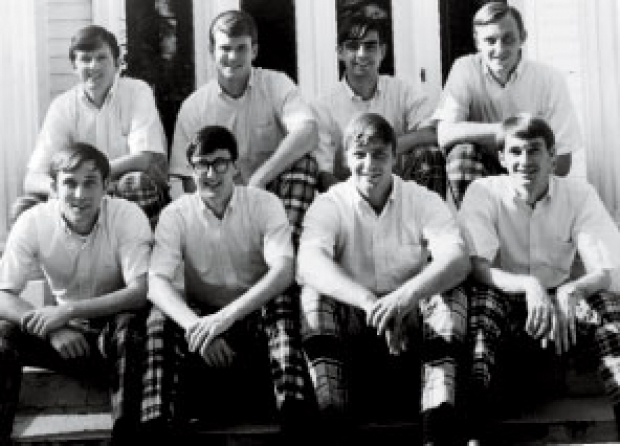The soundtrack for Southern carousing, “Double Shot (of My Baby’s Love)” keeps South Carolina's Swingin’ Medallions turned up.

Sean Connery was packing movie theaters with his new 007 blockbuster Dr. No; Jackie O’s pillbox hats were high fashion; and Marilyn Monroe blew out her candles for the last time.
The year was 1962, and Lander College students John McElrath and Joe Morris needed money to help pay their way through school. So they decided a band might put some cash in their pockets and attract the attention of a few coeds to boot. Little did they know the legendary status they would achieve—a reputation for great beach music that would endure for forty-seven years and counting.
Rewind a minute: McElrath and Morris had an early group called the Medallions, but, by 1963, they were looking for a new sound—one that incorporated rhythm, blues, and soul. Scouting Greenwood High School’s band for talent, they found two saxophone players. Next came guitar player Cubby Culbertson, then manager of a Greenwood music store and a former member of the popular Swingin’ Travelers. With a trumpet, two guitars, two saxophones, and a keyboard, the six-member band blended their sound into the high-energy style that catapulted them to stardom.
From Greenwood to Ninety-Six, the band played everywhere from high-school football games to tobacco warehouses. It wasn’t long before frat boys from the University of Georgia (visiting Lander for dates) recruited the band to play in Athens. “They were legends of the party years before they got around to recording the party song of the ages,” says Greg Haynes, author of the book The Heeey Baby Days of Beach Music.
Haynes retells how guitarist Cubby Culbertson first heard “Double Shot” performed by Dick Holler and the Holidays at an Army/Navy club in Columbia, South Carolina. He liked it and was playing it on his guitar at the record store in Greenwood when Morris asked, “What is that song you’re playing there, Cubby?” Although they quickly incorporated the tune into their live-set list, it would take three years to put the song to vinyl.
Instead of heading south to Atlanta to record with professional producers, McElrath took the band to Arthur Smith Studios in Charlotte. He recruited a mass of fans to recreate a frat-party atmosphere inside the studio. The decibel level went off the charts, and with only one take they produced the single on the band’s own label, which they named 4 Sale. As guitarist Cubby Culbertson later said, “We put the party on the record.”
The song’s popularity throughout the South took it to No. 1 on many local charts. And, taking the advice of legendary soul singer James Brown, they signed with Smash, a division of Mercury Records. When the major label bought national distribution rights, “Double Shot” took off from coast to coast.
Forty years later, the band has called eighty different musicians members of its ensemble, traveled the world, and even played a private concert for Frank Sinatra (at his daughter’s sixteenth birthday party in Los Angeles). Most recently, they performed on stage at the BI-LO Center with rock legend Bruce Springsteen who refers to “Double Shot” as the ultimate party tune.
But it doesn’t take a special invitation to assemble the Swingin’
Medallions to the stage. Every year, the group returns to its roots with a reunion performance in Greenwood where fans nod along to a double shot of nostalgia and music.